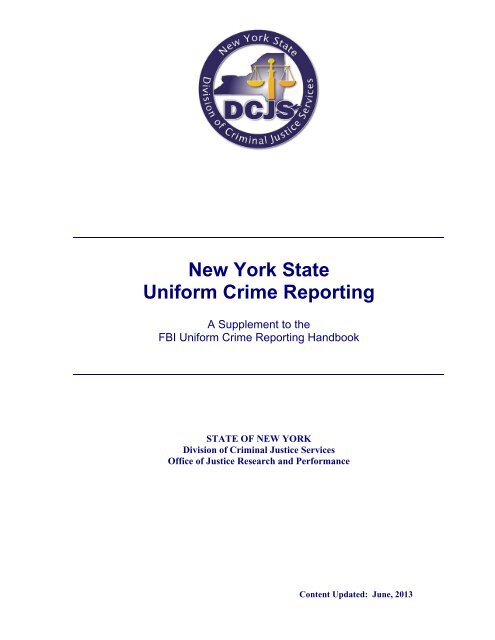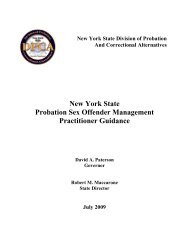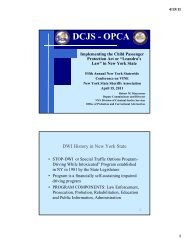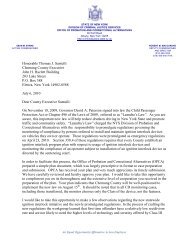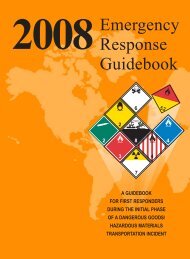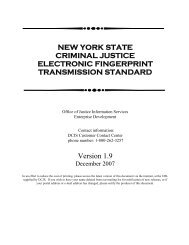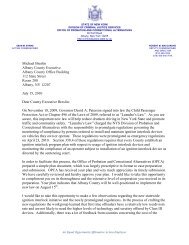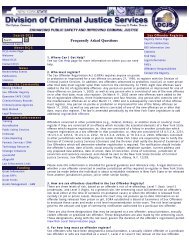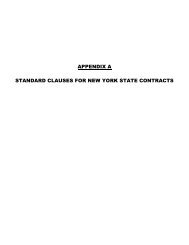New York State Uniform Crime Reporting - Division of Criminal ...
New York State Uniform Crime Reporting - Division of Criminal ...
New York State Uniform Crime Reporting - Division of Criminal ...
Create successful ePaper yourself
Turn your PDF publications into a flip-book with our unique Google optimized e-Paper software.
Copyright NoticeCopyright © 2013 by the <strong>New</strong> <strong>York</strong> <strong>State</strong> <strong>Division</strong> <strong>of</strong> <strong>Criminal</strong> Justice Services. Thispublication may be reproduced without the express written permission <strong>of</strong> the <strong>State</strong> <strong>of</strong> <strong>New</strong> <strong>York</strong><strong>Division</strong> <strong>of</strong> <strong>Criminal</strong> Justice Services provided that this copyright notice appears on all copies orsegments <strong>of</strong> the publication.Any questions regarding UCR submissions, the <strong>New</strong> <strong>York</strong> <strong>State</strong> specific requirements, orother crime reporting topics can be addressed to:<strong>New</strong> <strong>York</strong> <strong>State</strong> <strong>Division</strong> <strong>of</strong> <strong>Criminal</strong> Justice Services<strong>Crime</strong> <strong>Reporting</strong> UnitAlfred E. Smith Office Building, 6 th Floor80 South Swan StreetAlbany, <strong>New</strong> <strong>York</strong> 12210Telephone: 1-800-262-3257Email: infonysucr@dcjs.ny.gov
Table <strong>of</strong> ContentsJune 2013Introduction .................................................................................................................................................. 3Incident-Based <strong>Reporting</strong> in <strong>New</strong> <strong>York</strong> ..................................................................................................... 4<strong>Crime</strong> <strong>Reporting</strong> and Records Management Systems ............................................................................ 4Differences between <strong>New</strong> <strong>York</strong> <strong>State</strong> and FBI <strong>Reporting</strong> Requirements ............................................... 6Classifying and Scoring Offenses ......................................................................................................... 6<strong>Criminal</strong> Homicide ................................................................................................................................... 6Rape ......................................................................................................................................................... 6Robbery .................................................................................................................................................... 7Aggravated Assault ................................................................................................................................ 8Burglary ................................................................................................................................................... 8Larceny-Theft .......................................................................................................................................... 9Motor Vehicle Theft ................................................................................................................................. 9Arson ...................................................................................................................................................... 10Supplement to Return A ....................................................................................................................... 10Domestic Violence Victim Data ........................................................................................................... 13Age, Sex, Race, and Ethnic Origin <strong>of</strong> Persons Arrested, Under the Age <strong>of</strong> 18 .............................. 18<strong>New</strong> <strong>York</strong> <strong>State</strong> Juvenile Arrest Definition ......................................................................................... 18<strong>Reporting</strong> Police Dispositions <strong>of</strong> Juveniles Under the Age <strong>of</strong> 16 .................................................... 18<strong>Reporting</strong> Monetary Values for Larceny Offenses ............................................................................ 19<strong>Reporting</strong> Monetary Values <strong>of</strong> Personal Property Stolen During a Motor Vehicle Theft .............. 21<strong>Reporting</strong> Juvenile Clearances ........................................................................................................... 23Race Versus Ethnic Origin ................................................................................................................... 24Common <strong>Reporting</strong> Errors ....................................................................................................................... 25Motor Vehicle Theft Versus Unauthorized Use <strong>of</strong> a Motor Vehicle .................................................. 25<strong>Reporting</strong> Prior Offenses Which Recently Became Known to the Police ....................................... 25Classifying Menacing in the Second Degree as Aggravated Assault ............................................. 25Errors in <strong>Reporting</strong> Monetary Values ................................................................................................. 26UCR Program Forms ................................................................................................................................. 26
DIFFERENCES BETWEEN NEW YORK STATE AND FBI REPORTING REQUIREMENTSDifferences between <strong>New</strong> <strong>York</strong> <strong>State</strong> and FBI <strong>Reporting</strong>RequirementsThe differences between <strong>New</strong> <strong>York</strong> <strong>State</strong> (NYS) reporting requirements and theFederal Bureau <strong>of</strong> Investigation (FBI) reporting requirements are important to recognizebecause errors in reporting can contaminate the data and the resulting crime picture. Thedifferences fall into two categories: differences in classifying and differences in scoring.As a supplement to the FBI UCR Handbook, this manual only addresses the chapters andcrime classifications in which there are differences between the two programs.Classifying and Scoring OffensesClassifying is determining the proper crime categories in which to report <strong>of</strong>fenses.Scoring is counting the number <strong>of</strong> <strong>of</strong>fenses once they have been classified.The <strong>New</strong> <strong>York</strong> <strong>State</strong> Return A form collects more detailed information on certain<strong>of</strong>fenses than does the FBI form. <strong>New</strong> <strong>York</strong> subdivides several <strong>of</strong> the <strong>of</strong>fenseclassifications, allowing for the collection <strong>of</strong> details like the type <strong>of</strong> force used, location<strong>of</strong> the <strong>of</strong>fense, and the time <strong>of</strong> the <strong>of</strong>fense. When scoring <strong>of</strong>fenses on the Return A, it isimportant to utilize the correct subdivision when classifying the <strong>of</strong>fense.<strong>Criminal</strong> HomicideVehicular Homicide must not be reported as a <strong>Criminal</strong> Homicide throughUCR.In <strong>New</strong> <strong>York</strong> <strong>State</strong>, vehicular manslaughter is defined as causing the death <strong>of</strong> anotherperson by operation <strong>of</strong> a motor vehicle while intoxicated or ability impaired by alcohol ordrugs (PL 125.12), or by operation <strong>of</strong> a motor vehicle while impaired, with a suspendedor revoked license (PL 125.13). While causing these deaths is a criminal <strong>of</strong>fense in <strong>New</strong><strong>York</strong> <strong>State</strong>, the UCR program does not recognize vehicular manslaughter as anegligent manslaughter. Therefore, these <strong>of</strong>fenses should NOT be reported on theReturn A or the Supplementary Homicide Report (SHR).RapeIn 2012 the federal crime reporting definition <strong>of</strong> rape was expanded and is nowdefined as follows:“…penetration, no matter how slight, <strong>of</strong> the vagina or anus with any body part or object,or oral penetration by a sex organ <strong>of</strong> another person, without the consent <strong>of</strong> the victim.”To account for this change and allow for objective historical trends, <strong>New</strong> <strong>York</strong> <strong>State</strong>continues to collect the narrowly defined category <strong>of</strong> rape (commonly referred as thehistoric definition <strong>of</strong> rape) separately from those <strong>of</strong>fenses that now meet the expandedrape definition.6
DIFFERENCES BETWEEN NEW YORK STATE AND FBI REPORTING REQUIREMENTSIn 2013, The <strong>New</strong> <strong>York</strong> <strong>State</strong> <strong>Crime</strong> <strong>Reporting</strong> Program made the following twomodifications to the Part I crime category <strong>of</strong> rape:1. The literal associated with “Forcible Rape” was changed to “Rape (Pre 2013).”This crime category must still be used to report only those rapes that continue tomeet the historical definition <strong>of</strong> rape (Female victims penetrated vaginally by amale sex organ). Note: Agencies are still required to provide the followingweapon types for “Rape (Pre 2013).”Weapon Type• Handgun• Other Firearm• Other Weapon• Fear (No Weapon)2. Created a new Part I crime category entitled “Rape (2013 Expanded).” This newcrime category must only be used to report those <strong>of</strong>fenses that are now defined asrape due to 2013 expanded definition. Note: No weapon subclass is required for“Rape (2013 Expanded).”For more information related to the change in Part I rape, see the Expanded RapeDefinition <strong>Reporting</strong> Alert on the DCJS website.http://www.criminaljustice.ny.gov/crimnet/ojsa/crimereporting/rape_memo.pdfRobberyThe <strong>New</strong> <strong>York</strong> <strong>State</strong> <strong>Crime</strong> <strong>Reporting</strong> Program subdivides the <strong>of</strong>fense <strong>of</strong> robberyinto weapon types and location types:Weapon Type• Handgun• Other Firearm• Knife or Other Cutting Instrument• Other Dangerous Weapon• Strong Arm (Hands, Fists, Etc.)Location Type• Highway, Street, or Alley (areas outside <strong>of</strong> buildings and structures andnot within the confines <strong>of</strong> private property, such as roads, sidewalks, etc.)• Gas Station• Convenience Store• Bank• Other Commercial Buildings (business establishments other than gasstations, convenience stores, or banks)• Residence (locations used as residences, such as homes, apartment houses,motels, and other dwelling places)• Miscellaneous (other areas not included above, such as parks, schools, orlibraries)7
DIFFERENCES BETWEEN NEW YORK STATE AND FBI REPORTING REQUIREMENTSAggravated AssaultThe <strong>New</strong> <strong>York</strong> <strong>State</strong> <strong>Crime</strong> <strong>Reporting</strong> Program subdivides the <strong>of</strong>fense <strong>of</strong> aggravatedassault into the following weapon types and location types:Weapon Type• Handgun• Other Firearm• Knife or Other Cutting Instrument• Other Dangerous Weapon• Strong Arm (Hands, Fists, Etc.)Location Type• Street• Public Building• Residence• OtherNote: due to the presence <strong>of</strong> a weapon, Menacing in the Second Degree (PL120.14.01) must be classified as an aggravated assault for UCR purposes.Additionally, the FBI collects simple assaults in a separate category <strong>of</strong> the Part I<strong>of</strong>fenses. NYS requires that simple assaults be reported under Part II <strong>of</strong>fenses on theReturn A. Simple assaults should not be classified under the aggravated assaultcategory.BurglaryThe <strong>New</strong> <strong>York</strong> <strong>State</strong> <strong>Crime</strong> <strong>Reporting</strong> Program subdivides the <strong>of</strong>fense <strong>of</strong> burglary byResidence/Non-Residence, Time <strong>of</strong> Day and Entry Type:Residence/Non-Residence• Residence• Non-ResidenceTime <strong>of</strong> Day• Day• Night• Unknown TimeEntry Type• Forcible Entry• Unlawful Entry (No Force)• Attempted Forcible Entry8
DIFFERENCES BETWEEN NEW YORK STATE AND FBI REPORTING REQUIREMENTSThe Return A – Property Stolen by Classification Table. Note the total value.STATE OF NEW YORKDIVISION OF CRIMINAL JUSTICE SERVICESRETURN A - MONTHLY REPORT OF OFFENSES KNOWNTO THE POLICEAgency NameAgency ID#PROPERTY STOLEN BY CLASSIFICATIONCLASSIFICATION1. MURDER AND NON-NEGLIGENT MANSLAUGHTER 01DEMONETARY VALUE1,0002. FORCIBLE RAPE 023. ROBBERY 04(A) HIGHWAY (STREETS, ALLEYS, ETC.)(B) GAS OR SERVICE STATION 06250(C) CONVENIENCE STORE 08(D) BANK 09(E) OTHER COMMERCIAL BUILDING 11(F) RESIDENCE (ANYWHERE ON PREMISES) 13(G) M ISCELLANEOUS 155. BURGLARY(A) RESIDENCE (1) NIGHT (6 P.M . - 6 A.M .)1850(2) DAY (6 A.M . - 6 P.M .) 20(3) UNKNOWN 22(B) NON-RESIDENCE (1) NIGHT (6 P.M. - 6 A.M.) 24500(2) DAY (6 A.M . - 6 P.M .) 26(3) UNKNOWN 286. LARCENY - THEFT (EXCEPT MOTOR VEHICLE THEFT)(A) $200 AND OVER 03(B) $50 TO $199 05(C) UNDER $50 0757515040BY TYPE:(A) POCKET-PICKING 10(B) PURSE-SNATCHING 12(C) SHOPLIFTING 14(D) FROM M OTOR VEHICLES (EXCEPT PARTS AND ACCESS.) 1640150(E) MOTOR VEHICLE PARTS AND ACCESSORIES 17(F) BICYCLES 19(G) FROM BUILDING 21(H) FROM ANY COIN-OPERATED MACHINES (PARKING METERS, ETC) 23(I) ALL OTHER 257. MOTOR VEHICLE THEFT 27TOTAL 2957510,50013,06511
DIFFERENCES BETWEEN NEW YORK STATE AND FBI REPORTING REQUIREMENTSThe Return A – Property by Type and Value table. The total value <strong>of</strong> Property Stolen in this table is equal to thetotal value <strong>of</strong> property stolen in the Property Type by Classification table.PROPERTY BY TYPE AND VALUETYPE OF PROPERTYVALUE OF PROPERTYDESTOLENRECOVERED1. CURRENCY, NOTES, ETC. 01 A 250B2. JEWELRY AND PRECIOUS METALS 02 A 1,000B3. CLOTHING AND FURS 03 A 175B4. LOCALLY STOLEN MOTOR VEHICLES 04 A 10,500B75010,5005. OFFICE EQUIPMENT 05 A B6. TELEVISIONS, RADIOS, STEREOS, ETC 06 A 550B7. FIREARMS 07 A B8. HOUSEHOLD GOODS 08 A 550B9. CONSUMABLE GOODS 09 A 40B10. LIVESTOCK 10 A B11. MISCELLANEOUS 11 A BTOTAL 12 A 13,065B11,250NUMBER OF VEHICLES RECOVERED1. STOLEN LOCALLY AND RECOVERED LOCALLY 21 B22. STOLEN LOCALLY AND RECOVERED BY OTHERS 22 B3. STOLEN OUT OF TOWN AND RECOVERED LOCALLY 23 BADDITIONAL REPORTS REQUIREDREPORT SUBMITTEDNOTHING TO REPORTARREST OF PERSONS UNDER 18 31 41ARREST OF PERSONS 18 AND OVER 32 42SUPPLEMENTARY HOMICIDE 33 43OFFICERS KILLED OR ASSAULTED 34 44ARSON - FBI REPORT 35 45HATE CRIMES (BIAS) ** <strong>New</strong> FieldDOMESTIC VIOLENCE VICTIM DATADOMESTIC VIOLENCE VICTIM DATADEWIFE BYHUSBANDHUSBANDBY WIFECHILD BYPARENTPARENT BYCHILDOTHERDOMESTICRELATIONINTMATE PARTNERFEMALEVICTIMMALEVICTIMTOTALAGGRAVATED ASSAULT51 A B C D E F G HSIMPLE ASSAULT52 A B C D E F G HSEX OFFENSE53 A B C D E F G HOTHER VIOLENT OFFENSE54 A B C D E F G HVIOLATION OF PROTECTIVE ORDERTOTAL55 A B C D E F G H56 A B C D E F G HPrepared By Date Prepared Chief, Sheriff, Commissioner, or Superintendent12
DIFFERENCES BETWEEN NEW YORK STATE AND FBI REPORTING REQUIREMENTSDomestic Violence Victim Data(Revised April 2008)DCJS collects data concerning domestic violence in <strong>New</strong> <strong>York</strong> <strong>State</strong> as part <strong>of</strong> the<strong>Uniform</strong> <strong>Crime</strong> <strong>Reporting</strong> Program. Domestic violence is characterized by the current orformer relationship <strong>of</strong> the people involved in certain types <strong>of</strong> crime. Domestic violencevictim data are to be reported regardless <strong>of</strong> whether or not a complaint was filed or anarrest was made.For purposes <strong>of</strong> UCR crime reporting, domestic violence data should be capturedwhen the victim/<strong>of</strong>fender relationship is one <strong>of</strong> the following:1. Persons related by consanguinity (blood) or through marriage (affinity).2. Persons legally married to each other, or formerly married to each other.3. Persons who have a child in common, regardless <strong>of</strong> whether such personshave been married or lived together at any time.4. Persons who are currently living together, or who have previously livedtogether, in a significant intimate relationship, including same-sexcouples, to the extent that such relationship can be readily discerned.5. Persons who are currently or who have previously been involved in asignificant intimate relationship, including same-sex couples, to the extentthat such relationship can be readily discerned.The last page <strong>of</strong> the Return A includes a table for entering domestic violence victimdata. The counts in this table should include the total number <strong>of</strong> victims <strong>of</strong> domesticviolence-related <strong>of</strong>fenses within a reported incident, regardless <strong>of</strong> the top UCR <strong>of</strong>fense.For example, a simple assault by one spouse on the other is to be counted on the domesticviolence victim data table even if a more serious non-domestic violence-related <strong>of</strong>fensewas reported in the same incident. However, only one domestic violence-related<strong>of</strong>fense can be counted per victim. Therefore, victims <strong>of</strong> multiple <strong>of</strong>fenses in the sameincident should be counted only once on the Domestic Violence Victim Data table, in thetop domestic violence-related <strong>of</strong>fense for which they were reported as the victim.13
DIFFERENCES BETWEEN NEW YORK STATE AND FBI REPORTING REQUIREMENTSDomestic Violence <strong>Reporting</strong> HierarchyWhen reporting victims <strong>of</strong> domestic violence, it is important to count only one<strong>of</strong>fense per victim. When an incident involves multiple <strong>of</strong>fenses against the same victim,the following hierarchy <strong>of</strong> domestic violence-related <strong>of</strong>fenses should be used todetermine which <strong>of</strong>fense the victim should be reported under:• Murder• Rape• Aggravated Assault• Kidnapping• Sex Offenses (other than rape)• Simple Assault• Violation <strong>of</strong> Protective Order• Endangering the Welfare <strong>of</strong> a ChildAll the above <strong>of</strong>fenses classified as domestic violence are considered crimes againstpersons. Therefore, agencies should record one <strong>of</strong>fense for each victim on the DomesticViolence Victim Data table.The domestic violence table counts the above <strong>of</strong>fenses in the following five <strong>of</strong>fensegroupings:1. Aggravated Assault2. Simple Assault3. Sex Offense (includes sexual misconduct, rape, sodomy, sexual abuse, compellingprostitution, incest, and promoting the sexual performance <strong>of</strong> a child)4. Other Violent Offenses (murder, kidnapping, coercion, and endangering thewelfare <strong>of</strong> a child)5. Violation <strong>of</strong> a Protective OrderDomestic violence <strong>of</strong>fenses to be reported in the Domestic Violence Victim Datatable include any <strong>of</strong> the above <strong>of</strong>fenses (or attempts) perpetrated by people in domesticrelationships against each other. Refer to the UCR Cross-Reference Table for morespecific details on <strong>of</strong>fenses included in each <strong>of</strong> these categories, and their Penal Lawcitations.Victim categories on the UCR form are defined below. They are meant to bemutually exclusive.1. Wife by Husband: include wife, ex-wife, husband, and ex-husband.2. Husband by Wife: include husband, ex-husband, wife, and ex-wife.3. Child by Parent: include a child <strong>of</strong> any age, minor or adult.4. Parent by Child: include a child <strong>of</strong> any age, minor or adult.5. Other Family Relation: aunts, uncles, grandparents, sisters-in-law, cousins,and other blood and in-law relations.6. Intimate Partner (female victim): include all current and former intimatepartner relationships where the couple was never legally married.7. Intimate Partner (male victim): as above.14
DIFFERENCES BETWEEN NEW YORK STATE AND FBI REPORTING REQUIREMENTSExamplesAn argument breaks out between a husband and wife. The husband hits the wife.Police respond and charge the husband with simple assault.DOMESTIC VIOLENCE VICTIM DATADEWIFE BYHUSBANDHUSBANDBY WIFECHILDBYPARENTPARENTBYCHILDOTHERFAMILYRELATIONINTIMATE PARTNERFEMALEVICTIMMALEVICTIMTOTALAGGRAVATED ASSAULT 51 A B C D E F G HSIMPLE ASSAULT 52 A1B C D E F G H1SEX OFFENSE 53 A B C D E F G HOTHER VIOLENT OFFENSE 54 A B C D E F G HVIOLATION OF PROTECTIVEORDER 55 A B C D E F G HTOTAL 56 A1B C D E F G H1A young man, during an argument, swings at his ex-girlfriend with a butcher knife infront <strong>of</strong> their young son. Police respond and charge the man with aggravated assaultand endangering the welfare <strong>of</strong> a child.In this case, both <strong>of</strong>fenses are noted, one per victim. The endangering the welfare <strong>of</strong> achild is captured under the “Other Violent Offense” category.DOMESTIC VIOLENCE VICTIM DATADEWIFE BYHUSBANDHUSBANDBY WIFECHILDBYPARENTPARENTBYCHILDOTHERFAMILYRELATIONAGGRAVATED ASSAULT 51 A B C D E FINTIMATE PARTNERFEMALEVICTIM1GMALEVICTIMTOTAL1HSIMPLE ASSAULT 52 A B C D E F G HSEX OFFENSE 53 A B C D E F G HOTHER VIOLENT OFFENSE 541A B CD E F G HVIOLATION OF PROTECTIVEORDER 55 A B C D E F G HTOTAL 5611A B CD E FGH1215
DIFFERENCES BETWEEN NEW YORK STATE AND FBI REPORTING REQUIREMENTSA 37-year-old man engages in oral sexual conduct with his 13-year-old nephew.Police respond and charge the man with a criminal sexual act.DOMESTIC VIOLENCE VICTIM DATADEWIFE BYHUSBANDHUSBANDBY WIFECHILDBYPARENTPARENTBYCHILDOTHERFAMILYRELATIONINTIMATE PARTNERFEMALEVICTIMMALEVICTIMTOTALAGGRAVATED ASSAULT 51 A B C D E F G HSIMPLE ASSAULT 52 A B C D E F G H1SEX OFFENSE 53 A B C D EF G H1OTHER VIOLENT OFFENSE 54 A B C D E F G HVIOLATION OF PROTECTIVEORDER 55 A B C D E F G HTOTAL 561A B C D EF G H1A woman violates an order <strong>of</strong> protection and confronts her ex-husband and hisgirlfriend. An argument ensues and the woman hits the husband with a baseball bat. Thewoman is arrested for violating the order <strong>of</strong> protection and also charged with aggravatedassault.In this case, the ex-husband is the victim <strong>of</strong> two separate <strong>of</strong>fenses. Therefore, theaggravated assault is recorded because it is the top domestic violence <strong>of</strong>fense in theincident.DOMESTIC VIOLENCE VICTIM DATADEWIFE BYHUSBANDAGGRAVATED ASSAULT 51 A BHUSBANDBY WIFE1CHILD BYPARENTPARENTBY CHILDOTHERFAMILYRELATIONINTIMATE PARTNERFEMALE MALEVICTIM VICTIMTOTAL1C D E F G HSIMPLE ASSAULT 52 A B C D E F G HSEX OFFENSE 53 A B C D E F G HOTHER VIOLENT OFFENSE 54 A B C D E F G HVIOLATION OF PROTECTIVEORDER 55 A B C D E F G HTOTAL 561A BC D E F G H116
DIFFERENCES BETWEEN NEW YORK STATE AND FBI REPORTING REQUIREMENTSAn argument breaks out in a household among a mother, father and son. The sonstabs both his mother and father with a knife.DOMESTIC VIOLENCE VICTIM DATADEWIFE BYHUSBANDHUSBANDBY WIFECHILD BYPARENTAGGRAVATED ASSAULT 51 A B C DPARENTBY CHILD2OTHERINTIMATE PARTNERFAMILYRELATION FEMALE MALEVICTIM VICTIMTOTAL2E F G HSIMPLE ASSAULT 52 A B C D E F G HSEX OFFENSE 53 A B C D E F G HOTHER VIOLENT OFFENSE 54 A B C D E F G HVIOLATION OF PROTECTIVEORDER 55 A B C D E F G HTOTAL 562A B C DE F G H217
DIFFERENCES BETWEEN NEW YORK STATE AND FBI REPORTING REQUIREMENTSAge, Sex, Race, and Ethnic Origin <strong>of</strong> Persons Arrested, Under the Age <strong>of</strong> 18The guidance provided below is not intended to alter the reporting requirementsdefined by the Federal UCR program, but rather to clarify and reinforce what informationshould be captured as a result <strong>of</strong> law enforcement contact with juveniles.<strong>New</strong> <strong>York</strong> <strong>State</strong> Juvenile Arrest DefinitionAlthough <strong>New</strong> <strong>York</strong> <strong>State</strong> law provides for persons under the age <strong>of</strong> 18 to beconsidered adult <strong>of</strong>fenders, the FBI considers any individual under 18 years <strong>of</strong> age to be ajuvenile. For UCR reporting purposes, a juvenile “arrest” must be counted when a police<strong>of</strong>ficer has probable cause to believe that a youth between 7 and 18 years <strong>of</strong> age hascommitted a UCR <strong>of</strong>fense and is either• taken into custody, or• issued and appearance ticket.The term “taken into custody” means that the juvenile is no longer free to leave,regardless <strong>of</strong> whether he or she is handcuffed, placed in a police vehicle, or brought to apolice station. By extension, this would include cases in which a juvenile is a) takendirectly to Family Court or secure detention, b) given an appearance ticket, or c) warnedand released without further action.The key factor for counting an arrest is police intervention when the <strong>of</strong>ficer hasprobable cause to believe that the juvenile has engaged in behavior that constitutes aUCR <strong>of</strong>fense. All instances where a UCR <strong>of</strong>fense was believed to be committed shouldnot be counted as an “arrest.”<strong>Reporting</strong> Police Dispositions <strong>of</strong> Juveniles Under the Age <strong>of</strong> 16Since law enforcement has an increased level <strong>of</strong> discretion when dealing withjuveniles, the police disposition information is used to identify how the juvenile washandled by the reporting agency immediately after the “arrest.” This information is notmeant to track court dispositions.To ensure comparable disposition statistics, The National <strong>Crime</strong> <strong>Reporting</strong> Programrequires states to apply their age definition <strong>of</strong> juvenile when reporting the policedisposition <strong>of</strong> UCR juvenile arrests. Therefore, in <strong>New</strong> <strong>York</strong> <strong>State</strong> reporting agenciesmust provide the police disposition <strong>of</strong> only those juvenile arrests where the <strong>of</strong>fenderwas less than 16 years <strong>of</strong> age.Depending on the seriousness <strong>of</strong> the <strong>of</strong>fense and the <strong>of</strong>fender’s prior criminal record,a juvenile may be:• Warned by the police and released to parents, relatives, friends, or guardians;• Referred to the probation department or some other branch <strong>of</strong> the juvenile court;• Referred to welfare agencies;18
DIFFERENCES BETWEEN NEW YORK STATE AND FBI REPORTING REQUIREMENTS• Referred to other police agency; or• Referred to criminal or adult court.This information must be captured on the “Police Disposition <strong>of</strong> Juveniles” tablefound at the end <strong>of</strong> the UCR “Arrest <strong>of</strong> Persons Under 18” form. The table is used torecord the police disposition <strong>of</strong> ONLY those juveniles under 16 years <strong>of</strong> age that werereported as an “arrest” for committing a UCR <strong>of</strong>fense. Agencies must not account for thepolice dispositions <strong>of</strong> those 16 and 17 years old that have been reported as “arrests.” Thetotal number <strong>of</strong> police dispositions for that reporting month must equal the totalnumber <strong>of</strong> under 16 “arrests” for the reporting month.<strong>Reporting</strong> Monetary Values for Larceny Offenses6. LARCENY - THEFT Pocket Purse Shop From MV Parts From From Coin All(EXCEPT MV THEFT) DE Picking Snatching Lifting MV or Access. Bicycles Building Machine OtherA. $200 And Over 52 1 1Unfounded 53B. $50 To $199 55 1 2Unfounded 56C. Under $50 58 3 2Unfounded 59Monetary values associated with property stolen during a Larceny-Theft are recorded on theReturn A Supplement “Property Stolen by Classification” by value classification and propertytype classification. In the example above, the total number <strong>of</strong> larcenies reported on the Return Awas 10 including three value types and three property typesAs illustrated on the next page, the dollar value <strong>of</strong> property stolen during a Larceny-Theft isclassified by value on lines 3, 5, and 7 <strong>of</strong> the Larceny-Theft section <strong>of</strong> the Property Stolen byClassification table. Since there were 3 <strong>of</strong>fenses in the $50-$99 range, the minimum value thatcan appear is $150 with a maximum value <strong>of</strong> $597.The dollar value <strong>of</strong> property stolen during a Larceny-Theft is again reported in the“Monetary Value” column <strong>of</strong> the form (lines 10-25, next page). Since both sections refer to thesame property, the totals must be equal.19
DIFFERENCES BETWEEN NEW YORK STATE AND FBI REPORTING REQUIREMENTSSTATE OF NEW YORKDIVISION OF CRIMINAL JUSTICE SERVICESRETURN A - MONTHLY REPORT OF OFFENSES KNOWNTO THE POLICEAgency NameAgency ID#PROPERTY STOLEN BY CLASSIFICATIONCLASSIFICATION1. MURDER AND NON-NEGLIGENT MANSLAUGHTER 01DEMONETARY VALUE1,0002. FORCIBLE RAPE 023. ROBBERY 04(A) HIGHWAY (STREETS, ALLEYS, ETC.)(B) GAS OR SERVICE STATION 06250(C) CONVENIENCE STORE 08(D) BANK 09(E) OTHER COMMERCIAL BUILDING 11(F) RESIDENCE (ANYWHERE ON PREMISES) 13(G) MISCELLANEOUS 155. BURGLARY(A) RESIDENCE(1) NIGHT (6 P.M. - 6 A.M.)1850(2) DAY (6 A.M. - 6 P.M.) 20(3) UNKNOWN 22(B) NON-RESIDENCE (1) NIGHT (6 P.M. - 6 A.M.) 245006. LARCENY - THEFT (EXCEPT MOTOR VEHICLE THEFT)(2) DAY (6 A.M. - 6 P.M.) 26(3) UNKNOWN 28(A) $200 AND OVER 03(B) $50 TO $199 05(C) UNDER $50 0757515040BY TYPE:(A) POCKET-PICKING 10(B) PURSE-SNATCHING 12(C) SHOPLIFTING 14(D) FROM MOTOR VEHICLES (EXCEPT PARTS AND ACCESS.) 16(E) MOTOR VEHICLE PARTS AND ACCESSORIES 17240150375(F) BICYCLES 19(G) FROM BUILDING 21(H) FROM ANY COIN-OPERATED MACHINES (PARKING METERS, ETC) 23(I) ALL OTHER 257. MOTOR VEHICLE THEFT 27TOTAL 2910,50013,06520
DIFFERENCES BETWEEN NEW YORK STATE AND FBI REPORTING REQUIREMENTS<strong>Reporting</strong> Monetary Values <strong>of</strong> Personal Property Stolen During a MotorVehicle TheftWhen a motor vehicle containing personal property is stolen, the value <strong>of</strong> thepersonal property stolen is added to the value <strong>of</strong> the motor vehicle and recorded on theMotor Vehicle Theft line <strong>of</strong> the Property by Classification table. Combine the value <strong>of</strong>personal property with the value <strong>of</strong> the motor vehicle and enter it on Line 7. Do notrecord the value <strong>of</strong> personal property anywhere else on the form.STATE OF NEW YORKDIVISION OF CRIMINAL JUSTICE SERVICESRETURN A - MONTHLY REPORT OF OFFENSES KNOWNTO THE POLICEAgency NameAgency ID#PROPERTY STOLEN BY CLASSIFICATIONCLASSIFICATIONDEMONETARY VALUE1. MURDER AND NON-NEGLIGENT MANSLAUGHTER 012. FORCIBLE RAPE 023. ROBBERY 04(A) HIGHWAY (STREETS, ALLEYS, ETC.)(B) GAS OR SERVICE STATION 06(C) CONVENIENCE STORE 08(D) BANK 09(E) OTHER COMMERCIAL BUILDING 11(F) RESIDENCE (ANYWHERE ON PREMISES) 13(G) MISCELLANEOUS 155. BURGLARY(A) RESIDENCE(1) NIGHT (6 P.M. - 6 A.M.)18(2) DAY (6 A.M. - 6 P.M.) 20(3) UNKNOWN 22(B) NON-RESIDENCE (1) NIGHT (6 P.M. - 6 A.M.) 24(2) DAY (6 A.M. - 6 P.M.) 26(3) UNKNOWN 286. LARCENY - THEFT (EXCEPT MOTOR VEHICLE THEFT)(A) $200 AND OVER 03(B) $50 TO $199 05(C) UNDER $50 07BY TYPE:(A) POCKET-PICKING 10(B) PURSE-SNATCHING 12(C) SHOPLIFTING 14(D) FROM MOTOR VEHICLES (EXCEPT PARTS AND ACCESS.) 16(E) MOTOR VEHICLE PARTS AND ACCESSORIES 17(F) BICYCLES 19(G) FROM BUILDING 21(H) FROM ANY COIN-OPERATED MACHINES (PARKING METERS, ETC) 23(I) ALL OTHER 257. MOTOR VEHICLE THEFT 276,200TOTAL 2921
DIFFERENCES BETWEEN NEW YORK STATE AND FBI REPORTING REQUIREMENTSThe value <strong>of</strong> the golf clubs is recorded separately from the value <strong>of</strong> the motor vehicleon the Property by Type and Value table. Since the golf clubs were not recovered withthe motor vehicle, only the value <strong>of</strong> the motor vehicle is entered in the recovered column.PROPERTY BY TYPE AND VALUETYPE OF PROPERTYDESTOLENVALUE OF PROPERTYRECOVERED1. CURRENCY, NOTES, ETC. 01 A B2. JEWELRY AND PRECIOUS METALS 02 A B3. CLOTHING AND FURS 03 A B4. LOCALLY STOLEN MOTOR VEHICLES 04 A 5,000B5,0005. OFFICE EQUIPMENT 05 A B6. TELEVISIONS, RADIOS, STEREOS, ETC 06 A B7. FIREARMS 07 A B8. HOUSEHOLD GOODS 08 A B9. CONSUMABLE GOODS 09 A B10. LIVESTOCK 10 A B11. MISCELLANEOUS 11 A 1,200BTOTAL 12 A 6,200B5,000NUMBER OF VEHICLES RECOVERED1. STOLEN LOCALLY AND RECOVERED LOCALLY 21 B12. STOLEN LOCALLY AND RECOVERED BY OTHERS 22 B3. STOLEN OUT OF TOWN AND RECOVERED LOCALLY 23 BADDITIONAL REPORTS REQUIREDREPORT SUBMITTEDNOTHING TO REPORTARREST OF PERSONS UNDER 18 31 41ARREST OF PERSONS 18 AND OVER 32 42SUPPLEMENTARY HOMICIDE 33 43OFFICERS KILLED OR ASSAULTED 34 44ARSON - FBI REPORT 35 45HATE CRIMES (BIAS) ** <strong>New</strong> FieldDOMESTIC VIOLENCE VICTIM DATADEDOMESTIC VIOLENCE VICTIM DATAWIFE BYHUSBANDHUSBANDBY WIFECHILD BYPARENTPARENT BYCHILDOTHERFAMILYRELATIONINTIMATE PARTNERFEMALEVICTIMMALEVICTIMTOTALAGGRAVATED ASSAULTSIMPLE ASSAULTSEX OFFENSEOTHER VIOLENT OFFENSEVIOLATION OF PROTECTIVE ORDERTOTAL51 A B C D E F G H52 A B C D E F G H53 A B C D E F G H54 A B C D E F G H55 A B C D E F G H56 A B C D E F G HPrepared By Date Prepared Chief, Sheriff, Commissioner, or Superintendent22
DIFFERENCES BETWEEN NEW YORK STATE AND FBI REPORTING REQUIREMENTS<strong>Reporting</strong> Juvenile ClearancesIf an <strong>of</strong>fense is cleared and the arrestees include only juveniles (persons under the age <strong>of</strong>18), reporting agencies should record the clearances in the “Total Clearances” column and in the“Clearances Under 18” column. If an <strong>of</strong>fense includes both adult and juvenile arrestees, thereporting agency must score the clearance in the “Total Clearances” column only. The number<strong>of</strong> “Clearances Under 18” must not exceed the “Total Clearances” for the month. Agencies mustscore only the number <strong>of</strong> <strong>of</strong>fenses cleared, not persons arrested.An agency reports two larceny <strong>of</strong>fenses in a given month. A male age 24 hides on theloading dock <strong>of</strong> an electronics store. As its closing, he absconds with computer equipment. Heis later apprehended. In a separate <strong>of</strong>fense, a male age 17 is caught stealing music CDs from alocal record store. The manager calls the police and the 17 year old is arrested.If these were the only two reported larcenies in a given month, then the agency would score2 <strong>of</strong>fenses <strong>of</strong> Larceny-Theft (Shoplifting). “Net” would be 2, “Total Clearances” would be 2and “Clearances Under 18” would be 1.6. LARCENY - THEFT Pocket Purse Shop From MV Parts From From Coin AllNETTOTALREPORTED(Reported minus CLEARANCES CLEARANCES(EXCEPT MV THEFT) DE Picking Snatching Lifting M V or Access. Bicycles Building Machine Other OFFENSES UNFOUNDED DE Unfounded)UNDER 18(Include Under 18)A. $200 And Over 52 2 22 2 1Unfounded 53 0 54B. $50 To $199 55Unfounded 5657C. Under $50 58Unfounded 5960In a given month, an agency reports three separate thefts <strong>of</strong> a bicycle. In each case, thepolice arrested a juvenile under the age <strong>of</strong> 18. Score 3 <strong>of</strong>fenses <strong>of</strong> Larceny-Theft (Bicycles).“Net” would be 3, “Total Clearances” would be 3, and “Clearances Under 18”would be 3.6. LARCENY - THEFT Pocket Purse Shop From MV Parts From From Coin AllNETTOTALREPORTED(Reported minus CLEARANCES CLEARANCES(EXCEPT M V THEFT) DE Picking Snatching Lifting M V or Access. Bicycles Building Machine Other OFFENSES UNFOUNDED DE Unfounded)UNDER 18(Include Under 18)A. $200 And Over 52 3 33 3 3Unfounded 53 0 54B. $50 To $199 55Unfounded 5657C. Under $50 58Unfounded 596023
DIFFERENCES BETWEEN NEW YORK STATE AND FBI REPORTING REQUIREMENTSRace Versus Ethnic Origin“Hispanic” is not defined as a race. Persons <strong>of</strong> Hispanic heritage are members <strong>of</strong> the ethnicgroups based in the Spanish-speaking regions <strong>of</strong> Central America, South America, the CaribbeanOcean, and Europe. Hispanic people may consider themselves both Black and Hispanic, forexample. Phrases like “Black Hispanic” or “White Hispanic” describe a person by both race andethnicity. In the event an arrestee is not forthcoming regarding their ethnic origin, arrestingauthorities may rely on <strong>of</strong>ficer observation to determine the ethnicity <strong>of</strong> the <strong>of</strong>fender.On the ASR forms, the same arrestee is counted three times – once in the age and gendersection, once in the race section, and last in the ethnic origin section. Under Ethnic Origin,Hispanic arrestees are counted in one column and all other arrestees are counted in the other. Anexample for completing the forms correctly appears below.Thirteen (13) people <strong>of</strong> various ages were arrested for murder during the month.Their races are described as 10 White people, 1 Black person, and 2 Asian people. Two<strong>of</strong> the White arrestees considered themselves Hispanic.• In the age and sex sections, score those arrested in the appropriate age and sexdesignations.• In the race section, score 10 as White, 1 as Black, and 2 as Asian or PacificIslander.• In the ethnic origin section, score 2 in the Hispanics, 11 Non-Hispanic.STATE OF NEW YORKDIVISION OF CRIMINAL JUSTICE SERVICESAGE, RACE, SEX, AND ETHNIC ORIGIN OF PERSONS ARRESTED, 18 years <strong>of</strong> age and over(Include those released without having been formally charged)Agency NameAgency IDMonth - YearAGERACEETHNIC ORIGINAmericanCLASSIFICATION OF OFFENSESAsian orIndian orNotWhite BlackPacific HispanicNativeHispanicIslander65 &AlaskanDE Sex 18 19 20 21 22 23 24 25-29 30-34 35-39 40-44 45-49 50-54 55-59 60-64 Over TOTAL1A . M 1 5 1 2 3 1201 10 12 2 11M URDER F 1 1As the example above illustrates, the total numbers for Age, Sex, Race, and EthnicOrigin columns must equal each other.24
DIFFERENCES BETWEEN NEW YORK STATE AND FBI REPORTING REQUIREMENTSCommon <strong>Reporting</strong> ErrorsThe following section includes examples <strong>of</strong> the most common difficultiesencountered when completing UCR forms, and illustrates their solutions.Motor Vehicle Theft Versus Unauthorized Use <strong>of</strong> a Motor VehicleAn incident is classified as motor vehicle theft when the driver does not have, and has notreceived in the past, authorization to drive the vehicle. If the driver had prior authorization totake the vehicle, then the incident is classified as “Unauthorized Use <strong>of</strong> a Vehicle” on Part II <strong>of</strong>the Return A. Examples <strong>of</strong> unauthorized use would include; a son or daughter taking a parent’scar, a driver taking an employer’s car (which has been used in the past), or a renter keeping a carfrom a rental agency for longer than the contract period.<strong>Reporting</strong> Prior Offenses Which Recently Became Known to the PoliceThe UCR reporting rule is an <strong>of</strong>fense is reported for the date it becomes known to lawenforcement, regardless <strong>of</strong> when it actually occurred. For example, suppose the remains <strong>of</strong> abody are found buried in the woods in March <strong>of</strong> 2005. Investigation reveals the homicideoccurred in 1980. The <strong>of</strong>fense would be reported on the March 2005 UCR forms because the<strong>of</strong>fense became known to police in the 2005 reporting period, even though it occurred in 1980.Alternatively, suppose an aggravated assault occurred in August and resulted in the victimbeing hospitalized. The assault would be reported on the August Return A. If the victim diesfrom his injuries in September, the August report would need to be amended. The reportingagency must contact DCJS with notification <strong>of</strong> the death; the aggravated assault will besubtracted from the August report. The homicide would be reported by the agency on theSeptember Return A and Supplemental Homicide Report. It is important DCJS be made aware<strong>of</strong> the situation, to avoid reporting the same incident as two separate <strong>of</strong>fenses.Classifying Menacing in the Second Degree as Aggravated AssaultFor UCR purposes, the considerations for classifying an <strong>of</strong>fense as an aggravated assaultinclude: 1) the presence <strong>of</strong> a weapon, 2) the seriousness <strong>of</strong> the injuries, and 3) the intent <strong>of</strong> theassailant to cause serious injury. The use <strong>of</strong> any kind <strong>of</strong> weapon, as in Menacing in the SecondDegree (PL §120.14 sub 1), satisfies two <strong>of</strong> the three considerations, without any physical injuryhaving to occur. In the case <strong>of</strong> menacing, if there is any kind <strong>of</strong> weapon displayed or used, the<strong>of</strong>fense is classified on Part I as an aggravated assault. Even if no actual physical injury results,it is the presence <strong>of</strong> a weapon and the intent to cause serious physical injury which causes the<strong>of</strong>fense to be classified as an aggravated assault.In the late 1990s, DCJS notified agencies <strong>of</strong> the change in the classification <strong>of</strong> thissubsection <strong>of</strong> Menacing in the Second Degree from a Part II simple assault to a Part I aggravatedassault. DCJS asked law enforcement agencies to review simple assault counts to determine ifany Menacing in the Second Degree <strong>of</strong>fenses reported to them should be reclassified as Part I<strong>of</strong>fenses.25
DIFFERENCES BETWEEN NEW YORK STATE AND FBI REPORTING REQUIREMENTSErrors in <strong>Reporting</strong> Monetary ValuesDCJS edits the UCR report submissions for completeness and accuracy. When forms aresubmitted with potential errors, DCJS contacts the reporting agency requesting clarification.One <strong>of</strong> the most common errors is a discrepancy between <strong>of</strong>fenses reported and the value <strong>of</strong>property stolen during the <strong>of</strong>fenses. Discrepancies typically arise in two areas:• The total value <strong>of</strong> the Property Stolen by Classification table must equal the total value <strong>of</strong>the Property Stolen by Type table. If not, there is an error in calculation.• If a value is reported for stolen property on the property tables, there must also be acorresponding <strong>of</strong>fense reported on the Return A. For example, if a value is reported formotor vehicle thefts (line 27 <strong>of</strong> the Property Stolen by Classification table) at least oneMotor Vehicle Theft <strong>of</strong>fense must be scored on the Return A.In instances where there are multiple <strong>of</strong>fenses, monetary values are only recorded once -under the highest <strong>of</strong>fense classification. For example, if an <strong>of</strong>fender commits murder andremoves cash and jewelry from the crime scene, the <strong>of</strong>fense must be scored as a murder,and the value <strong>of</strong> the cash and jewelry only recorded on the Murder / Non-NegligentManslaughter line <strong>of</strong> the Property Stolen by Classification Table.UCR Program FormsThere are seven UCR forms.1. The Return A (Part I, Part II, Property, Domestic Violence and Nothing to Report)2. Age, Sex, Race and Ethnic Origin <strong>of</strong> Persons Arrested, 18 Years <strong>of</strong> Age and Over3. Age, Sex, Race and Ethnic Origin <strong>of</strong> Persons Arrested, Under 18 Years <strong>of</strong> Age4. Supplementary Homicide Report5. Monthly Return <strong>of</strong> Arson Offenses Known to Law Enforcement6. Hate <strong>Crime</strong> Incident Report7. Law Enforcement Officers Killed or Assaulted8. Agency Personnel ReportThese forms and instructions are available electronically on our website athttp://www.criminaljustice.ny.gov. The forms may be completed electronically andsubmitted as email attachments to DCJS at infonysucr@dcjs.ny.gov, or they may beprinted, completed manually and mailed to:<strong>New</strong> <strong>York</strong> <strong>State</strong> <strong>Division</strong> <strong>of</strong> <strong>Criminal</strong> Justice Services<strong>Crime</strong> <strong>Reporting</strong> UnitAlfred E. Smith Office Building, 6th Floor80 South Swan StreetAlbany, <strong>New</strong> <strong>York</strong> 1221026


